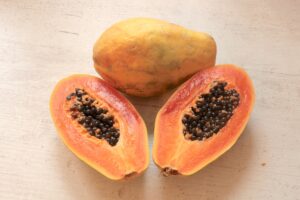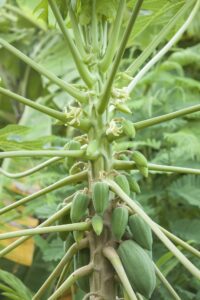B.N. – Carica papaya
Family – Caricaceae
Ch. No – 18
Origin – Tropical American (Mexico)
Fruit type – Berry
Edible part – Mesocarp
Inflorescense – Solitary (Cymose)
Watch Lecture Video
Important Point
- Bears on current season growth Axillary.
- Climacteric fruit
- Papaya is a polygamous plant.
Polygamous: having male, female, and bisexual flowers on the same plant. Also called polygamomonoecious or trimonoecious.
- Maximum area and production Andhra Pradesh.
- World’s largest producer – Brazil.
- India ranks fourth in the world in papaya production.
- Highest productivity after banana.

Papaya - According to the NHB database 2018 area and production of papaya are 138 thousand ha. and 5989 thousand MT respectably in India.
- Papaya is propagated commercially by seed.
- Seed rate 250-300 g/ha. (Gynodioecious)
400-500 g/ha. (Dioecious)
- 1gram =20 seeds of papaya
- The seeds are surrounded by gelatinous sarcotesta.
- Where dioecious varieties are cultivated, 10% of the male plants are planted with them.
- Papain contains 72.2% protein.
- The enzyme present in the dried latex of papaya is pepsin.
- The yellow color in papaya is due to Caricaxanthin.
- Carpine obtained from papaya is used as a diuretic and heart stimulant.
- Frost is the most influencing/limiting factor in papaya cultivation in North India.
- Dumping off is the most serious disease in papaya seedlings.
- Papaya plants are susceptible to waterlogging.
- Papaya is a thermosensitive crop.

Papaya Flowering - Carica candamarcensis – Mountain Papaya
Varieties
Gynodioecious varieties
- Pusa Delicious
- Pusa Majesty –highest papain yielders.
- Co-3
- Coorg Honey Dew – selection from Honey Dew (Madhu Bindu) (Hermaphrodite)
- Sunrise Solo – Pink flesh, produce no male plant
- Taiwan – Blood red colour
- Surya
Diecious varieties
- Pusa giant – Suitable for Tooty fruity and candies, wind-resistant.
- Pusa Dwarf
- Pusa Nanha – Extremely dwarf suitable for high-density planting (1.25 x 1.25 m2 6000 plant/ha.)
- Co-1- Dwarf
- Co-2
- Co-6 Selection from Pusa Majesty.
- Co-5 Cultivated mainly for papain extraction (Papain 1500-1600 kg / ha.
- Pink Flesh Sweet- TSS 12 to 140 Brix
- Pant-C-1
- Hatras Gold
- Sunnybank
- Betty
- Improved Petersons
Hybrid varieties
- Co-3:- Co-2 x Sunrise Solo
- Co-4:- Co-2 x Washinghton
- Co-7:- Co- 3 x Pusa Delicious x Coorg Honey Dew.
Climate
- Papaya is a tropical plant (hot and humid)
- Cultivation is done at an altitude of 1000 to 1200 meters above sea level.
- 22-260C temperature is suitable for papaya (temperature below 100C is harmful)
- Annual rainfall 1500 to 1800 mm.
- Mountain papaya tolerates low temperatures and grows at an altitude of 1500 and 2000 m. The fruit is about 8–10 cm long and ripens mainly from May to August.
Soil
- Well-drained, sandy loam soil rich in organic matter.
- pH – 6 to 7
- Calcium-rich and stony soils in which organic matter is found less are not suitable.
Propagation
- Papaya is mainly propagated by seed.
- The seed should be sown fresh. The viability of the seed is lost in about 45 days.
- Prior to sowing seeds are treated with Ceresin, Agrosan, Thiram at 2g/kg of seed.
- The time of sowing is February to April in North India.
- Western and Southern part June to the end of October.
Seed Rate
- Dioecious – 400 – 500gm / ha.
- Hermaphrodite – 200 – 300gm / ha.
Planting
- The pits of 45-60 cm3 size are dug at a distance of 1.8 x 1.8 or 2.0 x 2.0 m for dwarf varieties and 2.4 x 2.4 m for tall varieties.
- For dioecious varieties such as Co-1 or Co-2 or Co-6, three plants are usually planted per pit. Whereas, in hermaphrodite varieties, two plants per pit will be sufficient.
Planting time
- Generally, papaya is planted on a cloudy day at the beginning of the monsoon or when it is drizzling.
- Planting can be done in different seasons except for hot summers, cold winters, and periods of heavy rainfall.
- Planting seasons are –
- June – July
- September – October
- February – March
Manure and Fertilizers
- To maintain continuous growth, fertilizers should be given at frequent intervals (4-6 times) and light irrigation should be done after each application.
- N:P:K – 250:250:500 gm/plant and 40kg/plant FYM
Interculture and Intercropping
- At least two hoeings are necessary to keep weeds down.
- Diuron, Paraquat, Dalapan @ 2kg/ha control many weeds in papaya.
- Earthing up of the papaya plant should be done for support and protest them from direct contact with irrigation water.
- Any vegetable crop can be taken between two rows.
Removal of male plants
- When flowering begins, it is much easier to uproot male plants from dioecious papaya varieties. About 5-10% of male plants should be left for pollination.
- In hermaphrodite varieties, generally, one strong female plant is left per pit and the others are uprooted.
Sex Identification
- Dioecious types produce 50% female and 50% male plants.
- The peroxidase zymogram pattern established by polyacrylamide provides electrophoresis of extracts of leaf, petiole, and root tissues, zymograms of male plants have more bands than females.
- Studies on the sex expression of papayas at the University of Chittagong, Chittagong, Bangladesh, found that the levels of most amino acids were similar in both males and females except for proline, which is absent in female plants. Tryptophan levels in female plants are twice as high as in male plants.
Harvesting
- Papaya starts flowering and fruiting five months after planting and ripe fruits are ready for the first harvest in about 9-10 months after planting in tropical regions and 10-15 months after in sub-tropical regions of North India.
- Fruiting continues throughout the life span of the plant.
- Ripe fruits showing yellow streaks are harvested.
- The latex of the ripe fruit becomes watery.
Yield
- 20 to 50 fruits per plant weighing 25 to 50kg
- 40 to 50 tonnes/ha. First-year.
- 20 to 25 tonnes/ha second year.
Extraction of papain from papaya
- Choose half to three-quarter ripe fruits about 85-90 days old.
- Make an incision about 0.3 cm deep around the fruit from end to end i.e. in the longitudinal plane. This is done in the morning till 9 o’clock.
- Collect the latex in an areca nut, aluminum tray, or glass vessel.
- Repeated incision – On the unused surface of the same fruit, thrice at an interval of at least 3-4 days should be made.
- Add potassium metabisulfite 0.05% to the latex and then let it dry in the sun or let it dry at 50 – 550 C temperature.
- Make a powder from dried papaya and sieve through a 10-mesh sieve and store in polythene bags or in air-tight glass containers. It can be stored for 6 months without deterioration in quality. The yield of papain is affected by fruit variety, size, fruit maturity, season, management practices, etc.
Insect pest
-
Aphid (Myzus periscae)
- Sucks the sap from the tender parts of the plants, causes curling of the leaves, and is a carrier of diseases like PMV.
Control
- Keeping the garden relatively weed-free.
- Spray Methyl Demeton 2ml/Lit or Dimethoate 30 EC 2ml/Litre.
-
White fly (Trialeurodes variabilis)
- Both the adults and nymphs suck the plant sap.
- Reduce the vigor of the plant.
- In severe infestations, the leaves turn yellow and drop.
Control
- Spraying of Methyl Demeton 2 ml/lit or Dimethoate 30 EC 2ml/Litre.
-
Red spider mite (Teranychus sp.)
Papaya leaves and fruits are attacked by mites. Affected leaves turn yellow, and fruits become rough and brown in color.
Control
Spray 0.05% Sulphur or Lime Sulphur and repeat it at an interval of 10-12 days.
Disease (Fungal)
-
Damping-off (Phythium spp. Phytophthora spp., Rhizoctonia solani)
A common disease of nurseries. Affected plants rot from near the soil and fall to the ground. High humidity, high accumulation of water in the soil, and temperature 20-250C are suitable for growth.
Control measures
- Sterilize nursery soil with 2% formaldehyde before sowing.
- Avoid giving too much water.
- Do seed treatment with Ceresan at the rate of 2 gm/kg seed.
- The plant should be drenched with 1% of Captan or Bordeaux mixture.
-
Collar rot (Pythium aphanidermatum)
Affected plants show swelling in the collar portion of the stem and later cracks appear.
Control
- Remove and burn the affected plants.
- Provide good drainage.
- Spray or drench with 1% of Bordeaux mixture.
-
Fruit rot (Phytophthora palmivora)
- Firm rot occurs on uninjured fruits.
- Then soft water rot occurs on the injured fruit.
Control
- Apply virgin soil to the pit before planting.
- Provide good drainage.
- Spray 1% Bordeaux mixture.
Viral Diseases
-
Papaya Mosaic virus (PMV)
- The affected plants become stunted, leaves turn yellow, petiole show bending downward. Sometimes shoe strings-like symptoms may also appear. In severe cases, the plant may fail to flower and the plant may die.
- PMV spreads through sap, grafts, and aphid
Control
- Uproot and burn
- Control Aphids
-
Papaya leaf curl
- Vector – whitefly (Bemisia tabbaci)
- Affected leaves appear curled, shriveled, and deformed.
- The leaf size is significantly reduced.
Control
- Uproot and burn.
- Control white fly with roger 0.03% or monocrotophos 0.04%
